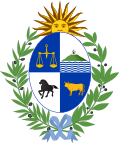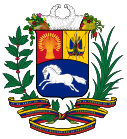Population and housing censuses by country
Parts of this article (those related to 2014, 2015) need to be updated. Please help update this article to reflect recent events or newly available information. (August 2017) |
This is a list of national population and housing censuses.
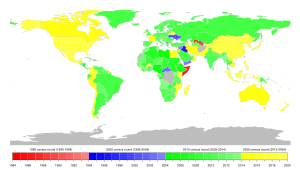
Census advisory
The United Nations recommends a census enumeration at least once every ten years, and once every five years for even better data, rather than simply relying on estimates and projections alone.[1] Complications to carrying out a census include tribal conflict, war, borders not demarcated, budget, inexperience, political snags, lack of manpower, and poor geographic information systems. A number of nations have not carried them out once a decade. It is not uncommon for a scheduled census to be deferred or delayed.
Lebanon has not held a census since 1932. Afghanistan is closing in on four decades without a census. DRC and Uzbekistan stand out as not having a census since before 1990. Madagascar has not had counts since the 1990s. Eritrea has only had one as a part of Ethiopia in the 1990s.
Methods of conducting population census
More countries are switching to using administrative data to hold a census. This allows a simulated census to be conducted by linking several different administrative databases at an agreed time.
| Using administrative data/combined data | Using collected data |
|---|---|
| Netherlands, Norway, Sweden, Switzerland, Denmark, Finland | United Kingdom, United States, Japan |
Africa
Algeria
This article needs to be updated. Please help update this article to reflect recent events or newly available information. (February 2018) |
Population and housing censuses have been carried out in Algeria in 1967, 1977, 1987, 1998,[2] 2008.[3] and 2018.[4]
Angola
General censuses of population and housing (Portuguese: Recenseamento Geral da População e Habitação (RGPH)) have been carried out in 1970 and 2014. The 1970 census counted 5,646,166 habitants. Preliminary results of the 2014 census have been published and final results will be published by the end of 2015. The 2014 census counted 25,789,024 habitants as of May 16, 2014.[5]
Benin
Population and housing censuses have been carried out in 1978, 1992, 2002 and 2013.[6][7] 2013 census preliminary results have been published.[7] Final results were published in 2015.[8]
Botswana
Censuses in Botswana are run by the Statistics Botswana (formerly Central Statistics Office). There have been twelve censuses in Botswana's history. The most recent occurred in April 2022.
Burkina Faso
The Institut National de la Statistique et de la Demographie has conducted four censuses: in 1975, 1985, 1996, and 2006.[9]
Congo (DRC)
The first and so far only census conducted in DR Congo dates from 1984.[10]
Egypt
The Statistical Department of the Ministry of Finance conducted the first census in 1882, which considered as a preparatory step; the first true population census was conducted in 1897. Thereafter, censuses were conducted at ten-year intervals in 1907, 1917, 1927 and so on. The last one being in 2017.
Ethiopia
Three censuses have been taken in
Ivory Coast
Four general censuses of population and housing (French: Recensement Général de la Population et de l'Habitat (RGPH)) have been carried out in,[11] the latest ones being in 1998 and 2014.[12]
Kenya
The first census in Kenya was conducted in 1948, when Kenya was still a colony administered by the British. Since 1969 census has been taken every ten years. The last census, overseen by the Kenya National Bureau of Statistics, was in 2019 and recorded a population of 47.6 million.[13]
Mauritius
Population and housing censuses for Mauritius was collected in 1972, 1983, 2000, and 2011; although respondents were asked to identify their race/ethnic origin in the 1972 census, this question was dropped from the following censuses because "the government felt that it was a divisive question".[14] The Statistics Act directed that all official censuses be conducted by Statistics Mauritius, as well as serve as the central depository for this information.[15]
Morocco
General censuses of population and housing (Arabic: الإحصاء العام للسكان والسكنى / French: Recensement Général de la Population et de l'Habitat (RGPH)) have been carried out since independence in 1960, 1971, 1982, 1994, 2004 and 2014.[16] The 2014 census results will be published on http://rgph-2014.hcp.ma/ by the end of 2014.
Mozambique
The first census was taken in 1980. The second in 1997. The third was taken August 1–14, 2007. The fourth and most recent was taken in 2017.
Namibia
In accordance with the Statistics Act No. 66 of 1976,
Nigeria
Population censuses have been taken in Nigeria during colonial time in 1866, 1871, 1896, 1901, 1911, 1921 and 1952. The censuses covered only the southern part of the country except for the 1952 census which was country wide, and the censuses before 1921 were based on administrative estimates rather than on an actual enumeration.
Censuses during independence were taken 1962, 1963, 1973, 1991 and 2006. The results of the 1962 census were considered inaccurate enough that a new census was ordered on February 19, 1963.[20] The results from 1973 and 2006 were highly disputed, but no recounts were taken. The preliminary results for 2006 indicates a population of 140 million people. 700,000 enumerators were engaged in this operation.
Somalia
There has been only one successful census in Somalia, carried out in 1975. The 1986 census remained incomplete, and its results were never published.[21]
South Africa
The Cape of Good Hope conducted the first modern scientific census in 1865, following the principles laid down by the British Colonial Office and repeated the exercise in 1875 and 1891.23 The Orange Free State followed in 1880 and 1890, copying many of the features of the Cape of Good Hope.24 The South African Republic (Transvaal) followed in 1890.However, the enumeration was restricted to the White population.
After the South African War of 1899-1902, all the colonies undertook censuses in April 1904, but although broad coordination took place the results were presented according to the views of the four individual census commissioners.28 The detailed coordination of censuses evident in pre-federation Australia was therefore not in evidence in South Africa.
The establishment of the Union of South Africa as a British dominion in 1910 necessitated a new start to enumeration in the country and the statistical definition of the new state and ordering of its population through the census.[22]
[23]
The first census of Union of South Africa was taken in 1911. Several enumerations have occurred since then,
Sudan
Population censuses have been carried out in Sudan in 1955/56, 1973 (national), 1983 (national) and 1993 (only north). A census was conducted in April 2008. Some areas—namely Darfur, Juba, and Malakal—were difficult to measure.[citation needed]
Togo
General population and housing censuses were carried out in 1960, 1970, 1981 and 2010.[25]
Tunisia
General censuses of population and housing (French: Recensement Général de la Population et de l'Habitat (RGPH)) have been carried out in 1921, 1926, 1931, 1936, 1946, 1956, 1966, 1975, 1984, 1994, 2004 and 2014.[26] First results[27] (20%) were published on September 12, 2014,[28] the final results will be published between January and December 2015.[29]
Uganda
The first censuses in Uganda were taken in 1911, 1921 and 1931. It was done in a rather primitive way. The enumeration unit was 'huts' and not individuals. More scientific censuses were taken 1948 and 1959 where the enumeration unit was persons. The census was however divided into two separate enumerations, one for Africans, and one for the non-African population.
The censuses during independence 1969, 1980, 1991 were taken jointly for all races. The censuses 1980 and 1991 included housing information and in addition a larger questionnaire for a sample of the population. However, the questionnaires for the 1980 were lost and only provisional figures are available from this census.
The census in 2002 involved some 50,000 enumerators and supervisors. It covered several topics including: population and housing; agriculture; and Micro- and small Enterprises administered at individual/household level. The Preliminary Results were published two weeks after the enumeration. The Final Results were released in March 2005, while the analytical findings and the district level results were scheduled to be released in the second quarter of 2006.[30]
The most recent census was in August 2014.[31]
Americas
Antigua and Barbuda
Population & Housing Censuses was carried out in 1991, 2001, and 2011.[32] The 2011 census was released in May 2014.
Argentina

National population censuses are carried out in Argentina roughly every ten years, the last ones having been carried out in 2001,[6] October 27, 2010 and May 18, 2022.
| Demographic and historical evolution of the Argentinian population since the first official census carried out in 1869. | |||
|---|---|---|---|
| N. | Year | Population Argentina |
Census of Population and Housing |
| 19th century | |||
| 1st | 1869 | 1869 Argentinian census | |
| 2nd | 1895 | 1895 Argentinian census | |
| 20th century | |||
| 3rd | 1914 | 1914 Argentinian census | |
| 4th | 1947 | 1947 Argentinian census | |
| 5th | 1960 | 1960 Argentinian census | |
| 6th | 1970 | 1970 Argentinian census | |
| 7th | 1980 | 1980 Argentinian census | |
| 8th | 1991 | 1991 Argentinian census | |
| 21st century | |||
| 9th | 2001 | 2001 Argentinian census | |
| 10th | 2010 | 2010 Argentinian census | |
| 11th | 2022 | 2022 Argentinian census | |
Barbados
Censuses on population sizes in Barbados are conducted by the Barbados Statistical Service (BSS). The last major census was conducted in 2021.
Bolivia

Bolivia became independent from Spain on August 6, 1825 and since that time the country has managed to carry out around 11 population and housing censuses throughout its history as an independent country.
The first population census of Bolivia was carried out in 1831 and four years later the second census was carried out in 1835, the third in 1845, the fourth in 1854 and finally the fifth census was in 1882, this being the last 19th century census.
During the 20th century, Bolivia only carried out four censuses; the first at the beginning of the century in 1900 and the second census was in 1950 (after 50 years) already in the middle of the 20th century. The next census was carried out 26 years later in 1976 and the next census was carried out after 16 years in 1992, this being also the last of the century.
At the beginning of the 21st century, Bolivia carried out a new population census in 2001 and after 11 years the next census was carried out again in 2012. Currently and after 12 years, Bolivia will carry out its third census on March 23, 2024, this being the third population and housing census of the century
| Demographic and historical evolution of the Bolivian population since the first official census carried out in 1831. | |||
|---|---|---|---|
| N. | Year | Population Bolivia |
Census of Population and Housing[33] |
| 19th century | |||
| 1st | 1831 | 1831 Bolivian census | |
| 2nd | 1835 | 1835 Bolivian census | |
| 3rd | 1845 | 1845 Bolivian census | |
| 4th | 1854 | 1854 Bolivian census | |
| 5th | 1882 | 1882 Bolivian census | |
| 20th century | |||
| 6th | 1900 | 1900 Bolivian census | |
| 7th | 1950 | 1950 Bolivian census | |
| 8th | 1976 | 1976 Bolivian census | |
| 9th | 1992 | 1992 Bolivian census | |
| 21st century | |||
| 10th | 2001 | 2001 Bolivian census | |
| 11th | 2012 | 2012 Bolivian census | |
| 12th | 2024 | TBD | 2024 Bolivian census |
| National Institute of Statistics of Bolivia (INE) | |||
Brazil
Brazil's Demographic Census is one of the most
Depending on the administrative hierarchy, some types of data are not published to respect confidentiality.
For example:
- The lower area of data collection is the census tract, with approximately 300 households, and information is collected on age, condition of the home, gender, income, among others.
- Districts: information on race, color, religion, disability, etc.
- Municipalities (cities): in addition to the information already described, there is information of GDP, industrial production, agricultural production, migration between cities to study or work, to live migration, inflation, employment rates, number of industries, the quantity of trade, etc.
Information is collected with handheld computers equipped with GPS receivers and digitized maps.
Next census was scheduled to begin August 1, 2020 but was delayed two times due to the ongoing COVID-19 pandemic.[34][35] The Census is scheduled to begin on August 1, 2022. More than one million people applied for 206.891 positions.[36]

| Demographic and historical evolution of the Brazilian population since the first official census carried out in 1872. | |||
|---|---|---|---|
| N. | Year | Population Brazil |
Census of Population and Housing |
| 19th century | |||
| 1st | 1872 | 1872 Brazilian census | |
| 2nd | 1890 | 1890 Brazilian census | |
| 20th century | |||
| 3rd | 1900 | 1900 Brazilian census | |
| 4th | 1920 | 1920 Brazilian census | |
| 5th | 1940 | 1940 Brazilian census | |
| 6th | 1950 | 1950 Brazilian census | |
| 7th | 1960 | 1960 Brazilian census | |
| 8th | 1970 | 1970 Brazilian census | |
| 9th | 1980 | 1980 Brazilian census | |
| 10th | 1991 | 1991 Brazilian census | |
| 21st century | |||
| 11th | 2000 | 2000 Brazilian census | |
| 12th | 2010 | 2010 Brazilian census | |
| 13th | 2022 | 2022 Brazilian census | |
Canada
The Canadian census is run by Statistics Canada. The 1666 census of New France was conducted by French intendant Jean Talon, when he took a census to ascertain the number of people living in New France. The method and data was later used when Canada was founded 201 years later. The individual provinces (sometimes in conjunction with each other) conducted censuses in the 19th century and before. In 1871, Canada's first formal census was conducted, which counted the population of Nova Scotia, Ontario, New Brunswick, and Quebec.
Censuses in Canada are conducted in five-year intervals. The last census was conducted in 2021. Censuses taken in mid-decade (1976, 1986, 1996, etc.) are referred to as quinquennial censuses. Others are referred to as decennial censuses. The first quinquennial census was conducted in 1956.
For the 2006 Census of Canada, respondents were able to complete their census questionnaire online for the first time. Other options for answering the questionnaire included postal mail (using a pre-paid envelope) and telephone (using an 800 number).
At a sub-national level, two provinces (Alberta and Saskatchewan) and two territories (Nunavut and Yukon) have legislation that allows local governments to conduct their own municipal censuses.[37]

| Demographic and historical evolution of the Canadian population since the first official census carried out in 1871. | |||
|---|---|---|---|
| N. | Year | Population Canada |
Census of Population and Housing |
| 19th century | |||
| 1st | 1871 | 1871 Canadian Census
| |
| 2nd | 1881 | 1881 Canadian Census | |
| 3rd | 1891 | 1891 Canadian Census | |
| 20th century | |||
| 4th | 1901 | 1901 Canadian Census | |
| 5th | 1911 | 1911 Canadian Census
| |
| 6th | 1921 | 1921 Canadian Census
| |
| 7th | 1931 | 1931 Canadian Census
| |
| 8th | 1941 | 1941 Canadian Census
| |
| 9th | 1951 | 1951 Canadian Census
| |
| 10th | 1956 | 1956 Canadian Census | |
| 11th | 1961 | 1961 Canadian Census | |
| 12th | 1966 | 1966 Canadian Census | |
| 13th | 1971 | 1971 Canadian Census | |
| 14th | 1976 | 1976 Canadian Census | |
| 15th | 1981 | 1981 Canadian Census | |
| 16th | 1986 | 1986 Canadian Census | |
| 17th | 1991 | 1991 Canadian Census
| |
| 18th | 1996 | 1996 Canadian Census
| |
| 21st century | |||
| 19th | 2001 | 2001 Canadian Census
| |
| 20th | 2006 | 2006 Canadian Census
| |
| 21th | 2011 | 2011 Canadian Census
| |
| 22th | 2016 | 2016 Canadian Census
| |
| 23th | 2021 | 2021 Canadian Census
| |
| 24th | 2026 | Projection | 2026 Canadian Census |
Chile
National population censuses are carried out in Chile every ten years by the National Statistics Institute (INE). The last one took place in 2012, but its results were dismissed by the INE due to a high omission rate and other problems.[38] A new abbreviated census took place in April 2017, with a full census to be carried out in 2022.[39] The last official census results are from 2002.
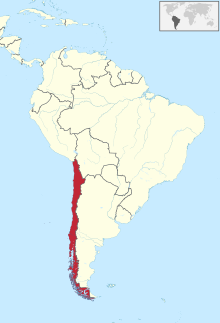
| Demographic and historical evolution of the Chilean population since the first official census carried out in 1835. | |||
|---|---|---|---|
| N. | Year | Population Chile |
Census of Population and Housing |
| 19th century | |||
| 1st | 1835 | 1835 Chilean Census | |
| 2nd | 1843 | 1843 Chilean Census | |
| 3rd | 1854 | 1854 Chilean Census | |
| 4th | 1865 | 1865 Chilean Census | |
| 5th | 1875 | 1875 Chilean Census | |
| 6th | 1885 | 1885 Chilean Census | |
| 7th | 1895 | 1895 Chilean Census | |
| 20th century | |||
| 8th | 1907 | 1907 Chilean Census | |
| 9th | 1920 | 1920 Chilean Census | |
| 10th | 1930 | 1930 Chilean Census | |
| 11th | 1940 | 1940 Chilean Census | |
| 12th | 1952 | 1952 Chilean Census | |
| 13th | 1960 | 1960 Chilean Census | |
| 14th | 1970 | 1970 Chilean Census | |
| 15th | 1982 | 1982 Chilean Census | |
| 16th | 1992 | 1992 Chilean Census | |
| 21st century | |||
| 17th | 2002 | 2002 Chilean Census | |
| 18th | 2012 | 2012 Chilean Census | |
| 19th | 2017 | 2017 Chilean Census | |
Colombia
Population and Housing Censuses in Colombia were conducted by the
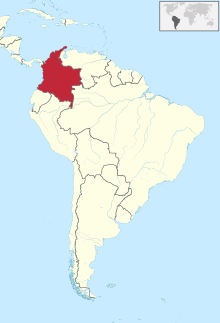
| Demographic and historical evolution of the Colombian population since the first official census carried out in 1825. | |||
|---|---|---|---|
| N. | Year | Population Colombia |
Census of Population and Housing |
| 19th century | |||
| 1st | 1825 | 1825 Colombian Census | |
| 2nd | 1835 | 1835 Colombian Census | |
| 3rd | 1843 | 1843 Colombian Census | |
| 4th | 1851 | 1851 Colombian Census | |
| 5th | 1864 | 1864 Colombian Census | |
| 6th | 1870 | 1870 Colombian Census | |
| 20th century | |||
| 7th | 1905 | 1905 Colombian Census | |
| 8th | 1912 | 1912 Colombian Census | |
| 9th | 1918 | 1918 Colombian Census | |
| 10th | 1928 | 1928 Colombian Census | |
| 11th | 1938 | 1938 Colombian Census | |
| 12th | 1951 | 1951 Colombian Census | |
| 13th | 1964 | 1964 Colombian Census | |
| 14th | 1973 | 1973 Colombian Census | |
| 15th | 1985 | 1985 Colombian Census | |
| 16th | 1993 | 1993 Colombian Census | |
| 21st century | |||
| 17th | 2005 | 2005 Colombian Census | |
| 18th | 2018 | 2018 Colombian Census
| |
Costa Rica
Costa Rica carried out its

| Demographic and historical evolution of the Costa Rican population since the first official census carried out in 1864. | |||
|---|---|---|---|
| N. | Year | Population Costa Rica |
Census of Population and Housing |
| 19th century | |||
| 1st | 1864 | 1864 Costa Rican census | |
| 2nd | 1883 | 1883 Costa Rican census | |
| 3rd | 1892 | 1892 Costa Rican census | |
| 20th century | |||
| 4th | 1927 | 1927 Costa Rican census | |
| 5th | 1950 | 1950 Costa Rican census | |
| 6th | 1963 | 1963 Costa Rican census | |
| 7th | 1973 | 1973 Costa Rican census | |
| 8th | 1984 | 1984 Costa Rican census | |
| 21st century | |||
| 9th | 2000 | 2000 Costa Rican census | |
| 10th | 2011 | 2011 Costa Rican census | |
| 11th | 2022 | 2022 Costa Rican census | |
Curaçao
General censuses of population and housing have been carried out in 1960, 1971, 1981, 1992, 2001, and 2011. In 2021 a new census will be conducted by the Central Bureau of Statistics of Curacao. For more information and the results of the older censuses visit the DIgitallibrary of CBS
Ecuador
The most recent censuses in Ecuador were in 2001 and 2010.
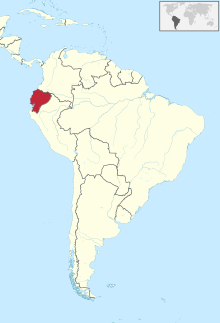
| Demographic and historical evolution of the Ecuadorian population since the first official census carried out in 1825. | |||
|---|---|---|---|
| N. | Year | Population Ecuador |
Census of Population and Housing[42] |
| 19th century | |||
| 1st | 1825 | 1825 Ecuadorian Census | |
| 2nd | 1840 | 1840 Ecuadorian Census | |
| 3rd | 1858 | 1858 Ecuadorian Census | |
| 4th | 1889 | 1889 Ecuadorian Census | |
| 20th century | |||
| 5th | 1909 | 1909 Ecuadorian Census | |
| 6th | 1926 | 1926 Ecuadorian Census | |
| 7th | 1933 | 1933 Ecuadorian Census | |
| 8th | 1942 | 1942 Ecuadorian Census | |
| 9th | 1950 | 1950 Ecuadorian Census | |
| 10th | 1962 | 1962 Ecuadorian Census | |
| 11th | 1974 | 1974 Ecuadorian Census | |
| 12th | 1982 | 1982 Ecuadorian Census | |
| 13th | 1990 | 1990 Ecuadorian Census | |
| 21st century | |||
| 14th | 2000 | 2000 Ecuadorian Census | |
| 15th | 2010 | 2010 Ecuadorian Census | |
| 16th | 2022 | 2022 Ecuadorian Census | |
Guatemala
Modern population censuses have been taken in Guatemala in 1930, 1950, 1964, 1973, 1981, 1994, 2002 and 2018.[43] Controversial censuses include those in 1950 and 1964 (misclassification of the Maya population) and 1994 (generally questioned). About 14,000,000 people live in Guatemala as of July 2009.

| Demographic and historical evolution of the Guatemalan population since the first official census carried out in 1880. | |||
|---|---|---|---|
| N. | Year | Population Guatemala |
Census of Population and Housing[44] |
| 19th century | |||
| 1st | 1880 | 1880 Guatemalan Census | |
| 2nd | 1893 | 1893 Guatemalan Census | |
| 20th century | |||
| 3rd | 1921 | 1921 Guatemalan Census | |
| 4th | 1940 | 1940 Guatemalan Census | |
| 5th | 1950 | 1950 Guatemalan Census | |
| 6th | 1964 | 1964 Guatemalan Census | |
| 7th | 1973 | 1973 Guatemalan Census | |
| 8th | 1981 | 1981 Guatemalan Census | |
| 9th | 1994 | 1994 Guatemalan Census | |
| 21st century | |||
| 10th | 2002 | 2002 Guatemalan Census | |
| 11th | 2018 | 2018 Guatemalan Census | |
Haiti
General censuses of population and housing (French: Recensement Général de la Population et de l'Habitat (RGPH)) have been carried out in 1950, 1971, 1982, 2003 and 2014.[45] First results of the 2014 census will be published between November and December 2014;[46] final results will be published in November 2015.[47]
Mexico
- National population censuses have been carried out in 1910, 1921, 1930, 1940, 1950, 1960, 1970, 1980, 1990, 1995, 2000, 2005 and 2010.[48]
- National economic censuses have been carried out in 1989, 1994, 1999, 2004, 2009 and 2014.[49]
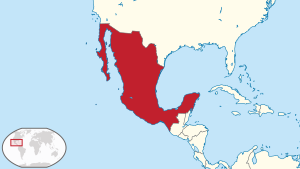
| Demographic and historical evolution of the Mexican population since the first official census carried out in 1880. | |||
|---|---|---|---|
| N. | Year | Population Mexico |
Census of Population and Housing[50] |
| 19th century | |||
| 1st | 1895 | 1895 Mexican Census | |
| 20th century | |||
| 2nd | 1900 | 1900 Mexican Census | |
| 3rd | 1910 | 1910 Mexican Census | |
| 4th | 1921 | 1921 Mexican Census | |
| 5th | 1930 | 1930 Mexican Census | |
| 6th | 1940 | 1940 Mexican Census | |
| 7th | 1950 | 1950 Mexican Census | |
| 8th | 1960 | 1960 Mexican Census | |
| 9th | 1970 | 1970 Mexican Census | |
| 10th | 1980 | 1980 Mexican Census | |
| 11th | 1990 | 1990 Mexican Census | |
| 21st century | |||
| 12th | 2000 | 2000 Mexican Census | |
| 13th | 2010 | 2010 Mexican Census | |
| 14th | 2020 | 2020 Mexican Census | |
Nicaragua

| Demographic and historical evolution of the Nicaraguan population since the first official census carried out in 1906. | |||
|---|---|---|---|
| N. | Year | Population Nicaragua |
Census of Population and Housing |
| 20th century | |||
| 1st | 1906 | 1906 Nicaraguan Census | |
| 2nd | 1920 | 1920 Nicaraguan Census | |
| 3rd | 1940 | 1940 Nicaraguan Census | |
| 4th | 1950 | 1950 Nicaraguan Census | |
| 5th | 1963 | 1963 Nicaraguan Census | |
| 6th | 1971 | 1971 Nicaraguan Census | |
| 7th | 1995 | 1995 Nicaraguan Census | |
| 21st century | |||
| 8th | 2005 | 2005 Nicaraguan Census | |
Panama

| Demographic and historical evolution of the Panamanian population since the first official census carried out in 1911. | |||
|---|---|---|---|
| N. | Year | Population Panama |
Census of Population and Housing |
| 20th century | |||
| 1st | 1911 | 1911 Panamanian Census | |
| 2nd | 1920 | 1920 Panamanian Census | |
| 3rd | 1930 | 1930 Panamanian Census | |
| 4th | 1940 | 1940 Panamanian Census | |
| 5th | 1950 | 1950 Panamanian Census | |
| 6th | 1960 | 1960 Panamanian Census | |
| 7th | 1970 | 1970 Panamanian Census | |
| 8th | 1980 | 1980 Panamanian Census | |
| 9th | 1990 | 1990 Panamanian Census | |
| 21st century | |||
| 10th | 2000 | 2000 Panamanian Census | |
| 11th | 2010 | 2010 Panamanian Census | |
| 12th | 2023 | 2023 Panamanian Census | |
Paraguay
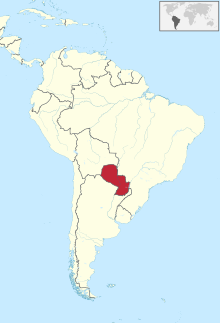
| Demographic and historical evolution of the Paraguayan population since the first official census carried out in 1846. | |||
|---|---|---|---|
| N. | Year | Population Paraguay |
Census of Population and Housing |
| 19th century | |||
| 1st | 1846 | 1846 Paraguayan Census | |
| 2nd | 1870 | 1870 Paraguayan Census | |
| 20th century | |||
| 3rd | 1950 | 1950 Paraguayan Census | |
| 4th | 1962 | 1962 Paraguayan Census | |
| 5th | 1972 | 1972 Paraguayan Census | |
| 6th | 1982 | 1982 Paraguayan Census | |
| 7th | 1992 | 1992 Paraguayan Census | |
| 21st century | |||
| 8th | 2002 | 2002 Paraguayan Census | |
| 9th | 2012 | 2012 Paraguayan Census | |
| 10th | 2022 | 2022 Paraguayan Census | |
Peru
The first census in

| Demographic and historical evolution of the Peruvian population since the first official census carried out in 1836. | |||
|---|---|---|---|
| N. | Year | Population Peru |
Census of Population and Housing[51][52] |
| 19th century | |||
| 1st | 1836 | 1836 Peruvian census | |
| 2nd | 1850 | 1850 Peruvian census | |
| 3rd | 1862 | 1862 Peruvian census | |
| 4th | 1876 | 1876 Peruvian census | |
| 20th century | |||
| 5th | 1940 | 1940 Peruvian census | |
| 6th | 1961 | 1961 Peruvian census | |
| 7th | 1972 | 1972 Peruvian census | |
| 8th | 1981 | 1981 Peruvian census | |
| 9th | 1993 | 1993 Peruvian census | |
| 21st century | |||
| 10th | 2005 | 2005 Peruvian census | |
| 11th | 2007 | 2007 Peruvian census | |
| 12th | 2017 | 2017 Peruvian census | |
| - | 2022 | INEI Estimates[53] | |
| 13th | 2027 | Projection | 2027 Peruvian census |
United States
The
The first
From 1950 onward, census forms were mailed to every address on record with the
The
By law (92 Stat. 915, Public Law 95-416, enacted on October 5, 1978), individual census records are sealed for 72 years.[56] The individual census data most recently released to the public was the 1940 census, released on April 2, 2012. Aggregate census data are released when available.
In addition to the decennial federal census, local censuses have also been conducted, for example, in Massachusetts, which conducted a statewide census every five years until 1985. Some states conducted limited censuses for various purposes, and these are typically located in state archives.
Next census was scheduled to begin 1 April 2020[57][circular reference] but delays due to the ongoing COVID-19 pandemic meant most areas did not assign enumerators and begin counting until after August 1, 2020, even while their questions are still written to tabulate information about a housing unit's status on the prior date.
The 2020 census counted for over 331 million people.[58]
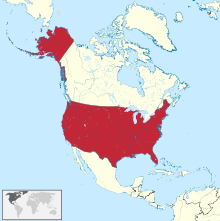
| Demographic and historical evolution of the United States population since the first official census carried out in 1790. | |||
|---|---|---|---|
| N. | Year | Population United States |
Census of Population and Housing |
| 18th century | |||
| 1st | 1790 | 1790 United States Census
| |
| 19th century | |||
| 2nd | 1800 | 1800 United States Census
| |
| 3rd | 1810 | 1810 United States Census
| |
| 4th | 1820 | 1820 United States Census
| |
| 5th | 1830 | 1830 United States Census
| |
| 6th | 1840 | 1840 United States Census
| |
| 7th | 1850 | 1850 United States Census
| |
| 8th | 1860 | 1860 United States Census
| |
| 9th | 1870 | 1870 United States Census
| |
| 10th | 1880 | 1880 United States Census
| |
| 11th | 1890 | 1890 United States Census
| |
| 20th century | |||
| 12th | 1900 | 1900 United States Census
| |
| 13th | 1910 | 1910 United States Census
| |
| 14th | 1920 | 1920 United States Census
| |
| 15th | 1930 | 1930 United States Census
| |
| 16th | 1940 | 1940 United States Census
| |
| 17th | 1950 | 1950 United States Census
| |
| 18th | 1960 | 1960 United States Census
| |
| 19th | 1970 | 1970 United States Census
| |
| 20th | 1980 | 1980 United States Census
| |
| 21th | 1990 | 1990 United States Census
| |
| 21st century | |||
| 22th | 2000 | 2000 United States Census
| |
| 23th | 2010 | 2010 United States Census
| |
| 24th | 2020 | 2020 United States Census
| |
| 25th | 2030 | Projection | 2030 United States Census |
Uruguay
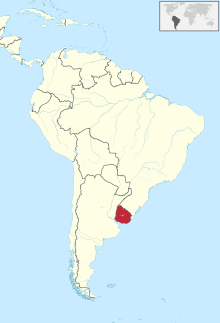
| Demographic and historical evolution of the Uruguayan population since the first official census carried out in 1852. | |||
|---|---|---|---|
| N. | Year | Population Uruguay |
Census of Population and Housing |
| 19th century | |||
| 1st | 1852 | 1852 Uruguayan census | |
| 2nd | 1860 | 1860 Uruguayan census | |
| 20th century | |||
| 3rd | 1908 | 1908 Uruguayan census | |
| 4th | 1963 | 1963 Uruguayan census | |
| 5th | 1975 | 1975 Uruguayan census | |
| 6th | 1985 | 1985 Uruguayan census | |
| 7th | 1996 | 1996 Uruguayan census | |
| 21st century | |||
| 8th | 2004 | 2004 Uruguayan census | |
| 9th | 2011 | 2011 Uruguayan census | |
| 10th | 2023 | 2023 Uruguayan census | |
Venezuela
The study of the population in Venezuela is in charge of the National Institute of Statistics, which is in charge of collecting, analyzing and publishing data. Its best known publication is the Population Census, which is carried out in a period of no more than 15 years.
The last study of this type was carried out in 2011 between September and November.[59]
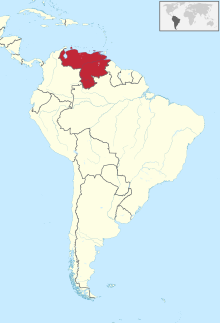
| Demographic and historical evolution of the Venezuelan population since the first official census carried out in 1873. | |||
|---|---|---|---|
| N. | Year | Population Venezuela |
Census of Population and Housing |
| 19th century | |||
| 1st | 1873 | 1873 Venezuelan Census | |
| 2nd | 1881 | 1881 Venezuelan Census | |
| 3rd | 1891 | 1891 Venezuelan Census | |
| 20th century | |||
| 4th | 1920 | 1920 Venezuelan Census | |
| 5th | 1926 | 1926 Venezuelan Census | |
| 6th | 1936 | 1936 Venezuelan Census | |
| 7th | 1941 | 1941 Venezuelan Census | |
| 8th | 1950 | 1950 Venezuelan Census | |
| 9th | 1961 | 1961 Venezuelan Census | |
| 10th | 1971 | 1971 Venezuelan Census | |
| 11th | 1981 | 1981 Venezuelan Census | |
| 12th | 1990 | 1990 Venezuelan Census | |
| 21st century | |||
| 13th | 2001 | 2001 Venezuelan Census | |
| 14th | 2011 | 2011 Venezuelan Census | |
| - | 2021 | World Bank estimates[60] | |
Asia
Afghanistan
A partial and incomplete population census was taken in Afghanistan in June 1979.[61][6] Wars since then have caused significant population displacement and there has not been an updated count nor does the nation seem to have the technical ability nor will to tackle a modern census.
Azerbaijan
Population censuses have been taken in Azerbaijan under Russian/Soviet rule in 1897, 1926, 1937, 1939, 1959, 1970, 1979, and 1989. Beginning in 1991, two more census have been carried out in Azerbaijan: one in 1999 and one in 2009.[62]
Bangladesh
Population censuses were conducted by the Bangladesh Bureau of Statistics (BBS) in 1974, 1981, 1991, 2001, 2011 and 2022.The 2022 Census was the nation's first digital census.[citation needed]
China
China's first censuses were irregular: the
The 1982 Chinese census was much more thorough and well-conducted than the first two, and similar censuses have been conducted decennially in 1990, 2000, and 2010.[63] These are the world's biggest censuses and over 6 million enumerators were engaged in the 2000[citation needed] and 2010 censuses.
Between the national censuses, 1% National Population Sample Surveys were taken in 1987, 1995, and 2005; 0.1% National Population Sample Surveys have been taken annually since 2000.[64] National agricultural, economic, and industrial censuses are also taken on a regular basis. The first economic census was taken in 2004 and the second 2008.[65]
Hong Kong
Census takes place every
India
The decennial census of India is the primary source of information about the demographic characteristics of the
The first census in India in modern times was conducted in 1873. First regular census was started in 1881 by
The census is conducted in two phases: first, house listing and house numbering phase and second, the actual population enumeration phase. The census is carried out by the canvassing method. In this method, each household is visited and the information is collected by specially trained enumerator. They collect data related to households e.g. number of members, water & electricity supply, ownership of land, vehicles, computers and other assets and services. In the second phase, total population is counted and statistics related to individuals are collected and saved into the governments hand.[66]
Indonesia
The first population census was done during the colonial era, 1930. Before that, a non-overall census was already conducted in 1920. After that census was done irregularly. The first census after independence was 1961, followed by 1971. Since 1980 it is conducted regularly every 10 years. In between, there is also economical census (every 10 years, five years after population census) and agricultural census (three years after population census). The last census was held in September 2020 (2020 Indonesian census).
Iran
The Statistical Center of Iran carries out nationwide population and housing censuses every ten years, the first of which conducted in 1956 (1335
Iraq
The Central Statistical Organization – Ministry of Planning of Iraq is responsible for population and housing censuses.
According to the British government in Iraq, the population estimate in 1920 was 3 million. In 1927, the General Directorate of Population carried out the census, the population estimate was 2,968,054. Later, There were another 8 censuses in the years 1934, 1947, 1957, 1965, 1977, 1987 and the last one that was carried out in 1997.
After the
Israel
The first census in the state of Israel was held in November 1948, six months after its creation, to establish the
Japan
Since 1920, Japan has conducted Population Census [ja] to collect census information every five years,[71] with the exceptions of the 6th in 1947 instead of 1945 and some extra censuses during 1944–1948.[72] A large-scale census (in the years ending in the digit 0) and a simplified one (in those ending in 5) has been undertaken alternately. They collected information as in October 1.[73] The Statistics Bureau is in charge of the exercise of censuses.[71]
The questionnaires were frequently changed in the early history of the Population Census, but they were almost fixed by the 1970s.[74]: 148 Since then, they include 16–23 topics, with a small difference between the large-scale censuses and the simplified ones.[75]: 135 They solicit information such as name, gender, relationship to head of household, year and month of birth, marital status, nationality, number of the household members, type and tenure of dwelling, floor area of the dwelling, number of hours worked during the week prior to October 1, employment status, name of employer and type of business, kind of work, and the place of work or schooling.[76] For the years ending in the digit 0, the questionnaire includes additional questions such as education, how long the respondent has lived at the current address, the place he/she lived five years ago, and the means of transportation to the workplace or school.[77]
Regardless of nationality or legal status, all residents in Japan are required to complete the census. All information collected by the census is confidential and protected by the Statistics Act [ja]. Information provided by census can never be used for any investigation purposes such as immigration control, police investigation, tax collections and so on.[78] After the census, all forms are destroyed.
For the first time in 2010, residents of Tokyo were given an option to complete the census questionnaires online in lieu of the conventional paper questionnaires. Unique ID and password were provided with the census form. Tokyo was chosen as the initial rollout for the online questionnaires due to the high concentration of people living in
The 2020 census was conducted in midst of global COVID-19 pandemic and the Japanese government urged the residents to respond the census online. Those who are unable to respond online may complete and mail back the paper questionnaires.[78] The online census questionnaires are available in Japanese, English, Simplified Chinese, Traditional Chinese, Korean, Vietnamese, Spanish, and Portuguese.[78] The paper census form is only written in Japanese, but translation is available in 29 different languages upon request.[79] Since 2020, administrative information can be used on limited basis, only to complete the number of persons from nonresponding households.[80]
Jordan
The first population census after the independence in 1946 was taken in 1952. It did only count the number of people in the households and could therefore be considered only to be a housing census. The first real complete census was taken in 1961. The following censuses have been taken in 1979, 1994 and 2004. The distribution of
Lebanon
No census has been conducted in Lebanon since 1932.[81] It indicated a population of 861,399 Lebanese.[82] Various estimates of the population have been taken since; in 1956 it was estimated a population of 1,411,416, with 54% Christian and 44% Muslim. Conducting a census since then has been complicated by various conflicts in the 1970s and 1980s,[83] as well as by the sensitivity of religious issues.[81]
Malaysia
The census in Malaysia is carried out every 10 years, like many nations, since 1960 (with the exception of the fourth census, which was carried out in 1991). The next census should be carried out in 2020. The most recent census was from July 6 to August 22, 2010.
Myanmar
A general census of population and housing has been carried out in 2014. Provisional results have been published and final results will be published in May 2015. The 2014 census counted 51,419,420 inhabitants.[84]
Nepal
Census in Nepal are taken by Central Bureau of Statistics. Population censuses are conducted every ten years in Nepal. The first was held in 1911 and the most recent was held in 2011. The census in 2021 is the first census of Federal Nepal.
Oman
Censuses have been taken in the
Pakistan
Philippines
The census of the Philippines is enumerated every 5 years (beginning in 1960, except in 2005 where it was moved to 2007 due to budgetary constraints) and the results are used to allocate Congressional seats (congressional apportionment) and government program funding.
The census is performed by the Philippine Statistics Authority. The first official census in the Philippines was carried out by the Spanish government pursuant to a royal decree calling for the counting of persons living as of the midnight of December 31, 1877. The first door-to-door census was conducted in 1903 to fulfill Public Act 467 which was approved by the U.S. Congress in July 1902. The last national census was held in 2020. For years between the censuses, the NSO issues estimates made using surveys and statistical models.
Saudi Arabia
Population censuses have been taken in Saudi Arabia in 1962/63 (incomplete), 1974 (complete but not reliable), 1992, 2004 and 2010. An agriculture census was taken in 1999.
Singapore
Population censuses have been taken in Singapore every ten years, in 1970, 1980, 1990, 2000, 2010 and 2020
South Korea
South Korea had its first "modern" census in 1925.[86]
The Census has been conducted 18 times every 5 years, Latest census was held in 2020.
Sri Lanka
The census in Sri Lanka is carried out by the Department of Census and Statistics every
Syria
The first population census in Syria was taken by the French Mandatory Regime in 1921–22. This is however not considered reliable. Censuses during independence have been taken 1947, 1960 (the first comprehensive demographic investigation), 1970, 1976 (a sample census), 1981, 1994 and 2004 and the next would be taken at 2017.
Taiwan
The first census in Taiwan was conducted in 1905, while Taiwan was under Japanese rule.[88]
Thailand
A census is conducted every 10 years, the latest being in 2010. The
Turkey
The Turkish census is run by the Turkish Statistical Institute. The first census in Turkey was conducted in 1927. After 1935, it took place every 5 years until 1990. Now, the census takes place every 10 years. The last census was in 2000. It can be noted that the census enumeration takes place on one single day in Turkey (in other countries it takes 1–2 weeks). This required some 900,000 enumerators in 2000. The 15th census based on improved geographical information systems is planned for 2010.
A census was taken in the
Uzbekistan
The last census in Uzbekistan was carried out in 1989 during Soviet rule. Uzbekistan itself has never carried one out.
Europe
Albania
The latest population census was conducted in Albania on September 30, 2011.[89]
The previous census was conducted in April 2001.

| Demographic and historical evolution of the Albanian population since the first official census carried out in 1923. | |||
|---|---|---|---|
| N. | Year | Population Albania |
Census of Population and Housing |
| 20th century | |||
| 1st | 1923 | 1923 Albanian Census | |
| 2nd | 1930 | 1930 Albanian Census | |
| 3rd | 1945 | 1945 Albanian Census | |
| 4th | 1950 | 1950 Albanian Census | |
| 5th | 1955 | 1955 Albanian Census | |
| 6th | 1960 | 1960 Albanian Census | |
| 7th | 1969 | 1969 Albanian Census | |
| 8th | 1979 | 1979 Albanian Census | |
| 9th | 1989 | 1989 Albanian Census | |
| 21st century | |||
| 10th | 2001 | 2001 Albanian Census | |
| 11th | 2011 | 2011 Albanian Census | |
Austria
The Austrian census is run by Statistics Austria. It is carried out every ten years, the last one on October 31, 2011.

| Demographic and historical evolution of the Austrian population since the first official census carried out in 1869. | |||
|---|---|---|---|
| N. | Year | Population Austria |
Census of Population and Housing[92] |
| 19th century | |||
| 1st | 1869 | 1869 Austrian Census | |
| 2nd | 1880 | 1880 Austrian Census | |
| 3rd | 1890 | 1890 Austrian Census | |
| 20th century | |||
| 4th | 1900 | 1900 Austrian Census | |
| 5th | 1910 | 1910 Austrian Census | |
| 6th | 1934 | 1934 Austrian Census | |
| 7th | 1951 | 1951 Austrian Census | |
| 8th | 1961 | 1961 Austrian Census | |
| 9th | 1971 | 1971 Austrian Census | |
| 10th | 1981 | 1981 Austrian Census | |
| 11th | 1991 | 1991 Austrian Census | |
| 21st century | |||
| 12th | 2001 | 2001 Austrian Census | |
| 13th | 2011 | 2011 Austrian Census | |
| 14th | 2021 | 2021 Austrian Census | |
Belgium
The Belgium census is run by Statistics Belgium. The first census was carried out in 1846 then it is carried out every 10 years. The last census was taken in 2011. This is the first registered based census.[1]

| Demographic and historical evolution of the Belgian population since the first official census carried out in 1846. | |||
|---|---|---|---|
| N. | Year | Population Belgium |
Census of Population and Housing |
| 19th century | |||
| 1st | 1846 | 1846 Belgian Census | |
| 2nd | 1856 | 1856 Belgian Census | |
| 3rd | 1866 | 1866 Belgian Census | |
| 4th | 1876 | 1876 Belgian Census | |
| 5th | 1880 | 1880 Belgian Census | |
| 6th | 1890 | 1890 Belgian Census | |
| 20th century | |||
| 7th | 1900 | 1900 Belgian Census | |
| 8th | 1910 | 1910 Belgian Census | |
| 9th | 1920 | 1920 Belgian Census | |
| 10th | 1930 | 1930 Belgian Census | |
| 11th | 1947 | 1947 Belgian Census | |
| 12th | 1961 | 1961 Belgian Census | |
| 13th | 1970 | 1970 Belgian Census | |
| 14th | 1981 | 1981 Belgian Census | |
| 15th | 1991 | 1991 Belgian Census | |
| 21st century | |||
| 16th | 2001 | 2001 Belgian Census | |
| 17th | 2011 | 2011 Belgian Census | |
| 18th | 2021 | 2021 Belgian Census | |
Bosnia and Herzegovina
Population censuses in Bosnia and Herzegovina were conducted in 1879, 1885, 1895, 1910, 1921, 1931, 1948, 1953, 1961, 1971, 1981 and 1991. The 2013 Census was organized in period between October 1–15, 2013. This is the first census after the end of the Bosnian War.
Bulgaria
Bulgarian governors organized a national census soon after the liberation of the Bulgarian lands. In 1881 a census took place in the Principality, while in 1884 a census was organized in Eastern Rumelia. The first census covering the unified state took place in 1887.
Since these first accounts, Bulgarian authorities had organized several population censuses: 1892, 1900, 1905, 1910, 1920, 1926, 1934, 1946, 1956, 1965, 1975, 1985, 1992, 2001, and 2011.
The data provided in the Bulgarian censuses from 1888 until World War II is regarded as highly reliable[citation needed] according to the standards of the time. The Bulgarian leading statisticians of the period were generally educated in Western universities and participated vividly in the international cooperation, therefore insisted and succeeded in introducing the best practices of the time. The quality of the data provided of later censuses is a matter of debate.[citation needed] The religion question in the 2001 census didn't allow the unaffiliated Bulgarians to be counted as such.

| Demographic and historical evolution of the Bulgarian population since the first official census carried out in 1880. | |||
|---|---|---|---|
| N. | Year | Population Bulgaria |
Census of Population and Housing |
| 19th century | |||
| 1st | 1880 | 1880 Bulgarian Census | |
| 2nd | 1887 | 1887 Bulgarian Census | |
| 3rd | 1892 | 1892 Bulgarian Census | |
| 20th century | |||
| 4th | 1900 | 1900 Bulgarian Census | |
| 5th | 1905 | 1905 Bulgarian Census | |
| 6th | 1910 | 1910 Bulgarian Census | |
| 7th | 1920 | 1920 Bulgarian Census | |
| 8th | 1926 | 1926 Bulgarian Census | |
| 9th | 1934 | 1934 Bulgarian Census | |
| 10th | 1946 | 1946 Bulgarian Census | |
| 11th | 1956 | 1956 Bulgarian Census | |
| 12th | 1965 | 1965 Bulgarian Census | |
| 13th | 1975 | 1975 Bulgarian Census | |
| 14th | 1985 | 1985 Bulgarian Census | |
| 15th | 1992 | 1992 Bulgarian Census | |
| 21st century | |||
| 16th | 2001 | 2001 Bulgarian Census | |
| 17th | 2011 | 2011 Bulgarian Census | |
| 18th | 2021 | 2021 Bulgarian Census | |
Croatia
The census in Croatia is carried out every 10 years. The last census was taken in 2021 with final population count of 3.9 million.[93] The first census was in 1857 when what is now Croatia was part of the Austrian Empire.
Cyprus
This section does not cite any sources. Please help improve this section by adding citations to reliable sources. Unsourced material may be challenged and removed. (November 2013) (Learn how and when to remove this message) |
The British carried out seven censuses in Cyprus in total: six at ten-year intervals between 1881 and 1931, and the last in 1946. Following the establishment of the modern state, there have been seven more censuses: in 1960 (the year of establishment), 1973, 1976, 1982, 1992, 2001 and 2011. The Statistical Service of the Cypriot government counts from the first British census, i.e. the latest census, in 2011, is referred to as the 14th census. In Northern Cyprus there have been three censuses: in 1996, 2006 and 2011. All three have been a matter of controversy, both in the north and the south, and abroad.
Czech Republic
The census in the Czech Republic is carried out every 10 years by the Czech Statistical Office. The last census was taken in 2011. Earlier censuses were taken in 1869, 1880, 1890, 1900, 1910, 1921, 1930, 1950, 1961, 1970, 1980, 1991 and 2001.
The results of the last census are also available via the interactive model based software.
Denmark
The first Danish census was in 1700–1701, and contained statistical information about adult men. Only about half of it still exists. A census of school children was taken during the 1730s.
Following these early undertakings, the first census to attempt completely covering all citizens (including women and children who had previously been listed only as numbers) of
.After that, censuses followed somewhat regularly in 1787, 1801, and 1834, and between 1840 and 1860, the censuses were taken every five years, and then every ten years until 1890. Special censuses for Copenhagen were taken in 1885 and 1895.
In the 20th century, censuses were taken every five years from 1901 to 1921, and then every ten years from 1930. The last traditional census was taken in 1970.
A limited population census based on registers was taken in 1976. From 1981 and each year onwards information that corresponds to a population and housing census is retrieved from registers. Denmark was the first country in the world to conduct these censuses from administrative registers. The most important registers are the Population Register (
It is possible to search a portion of the Danish censuses online at the Dansk Demografisk Database,[96] and also view scanned versions at Arkivalier Online.[97]
Estonia
Population censuses have been carried out in 1881,[98] 1897,[98] 1922,[98] 1934,[98] 1959,[99] 1970,[99] 1979,[99] 1989,[99] 2000[100] and 2011.[101][102]
The censuses of 1881 and 1897 were carried out during the reign of the
The 1922 and 1934 censuses were carried out by the independent Republic of Estonia. The 1959, 1979 and 1989 censuses were carried out by the
Finland
The first population census was taken in 1749 when Finland was a part of Sweden. Although the parliament authorized a modern census in 1938, it was not undertaken until 1950. Finland has an accurate population registry system, thus censuses are in practice conducted by studying the registry, rather than as a separate project. Statistics Finland publishes various statistics on population: preliminary population statistics are published monthly, population structure report is published annually and population projections every three years. Once in ten years, the official locations and demarcations for densely populated areas (taajama) for traffic purposes, and official numbers of the speakers of national languages (Finnish or Swedish), for bilinguality, are reviewed.
France
The census in France is currently carried out by
Germany
This section's factual accuracy may be compromised due to out-of-date information. Please help update this article to reflect recent events or newly available information. (October 2012) |
The first systematic population on the European continent was taken in 1719 in Prussia (roughly corresponding to today's northern Germany and western Poland).
The first large-scale census in the German Empire took place in
Greece
Census takes place every
Hungary
Official decennial censuses have been taken in Hungary since 1870; the latest one – in line with the recommendations of the United Nations and the Statistical Office of the European Union – was carried out in 2011. Starting from 1880 the Hungarian census system was based on native language (the language spoken at home in the early life of the person and at the time of the survey), vulgar language (the most frequently used language in the family), and other spoken languages.
Iceland
The first Icelandic census took place in
The need for censuses was eliminated through the setting up, in 1952, of the National Registry (Þjóðskrá), which later merged with other entities to form
The National Registry doubles as an
Ireland
Population censuses covering all of Ireland were conducted every ten years from 1821 to 1911 inclusive. The first census following independence was conducted in 1926 and done every ten years until 1946. Since then, most censuses have been conducted every five years from 1951 to 2011 with two exceptions. Instead of censuses in 1976 and 2001, they were instead conducted in 1979 and 2002 respectively. The next census is scheduled for 2022, having been postponed from 2021 due to the COVID-19 pandemic.[107] All original census returns from 1901 onwards survive, together with some 19th century fragments.[108]
The census in Ireland is carried out by the Central Statistics Office.[109] The census is taken every five years, with more detailed information collected in years ending in 1 and less in the years ending in 6. The 1976 census was cancelled as a cost-saving measure, but a supplementary census was held in 1979 after it became apparent that the 1970s had seen major demographic changes.[110] The census scheduled for 2001 was postponed until 2002 due to the outbreak of foot-and-mouth disease.[111]
Data from the 1901 Census of Ireland and the 1911 census of Ireland were first made publicly available in 1961.[112][113] Subsequent census records will be made available 100 years after collection.[112] The 1901 and 1911 census returns, together with the 19th century fragments, are freely available to view at the National Archives of Ireland website.[114]
Italy
The census in Italy is carried out by

| Demographic and historical evolution of the Italian population since the first official census carried out in 1861. | |||
|---|---|---|---|
| N. | Year | Population Italy |
Census of Population and Housing |
| 19th century | |||
| 1st | 1861 | 1861 Italian Census | |
| 2nd | 1871 | 1871 Italian Census | |
| 3rd | 1881 | 1881 Italian Census | |
| 20th century | |||
| 4th | 1901 | 1901 Italian Census | |
| 5th | 1911 | 1911 Italian Census | |
| 6th | 1921 | 1921 Italian Census | |
| 7th | 1931 | 1931 Italian Census | |
| 8th | 1936 | 1936 Italian Census | |
| 9th | 1951 | 1951 Italian Census | |
| 10th | 1961 | 1961 Italian Census | |
| 11th | 1971 | 1971 Italian Census | |
| 12th | 1981 | 1981 Italian Census | |
| 13th | 1991 | 1991 Italian Census | |
| 21st century | |||
| 14th | 2001 | 2001 Italian Census | |
| 15th | 2011 | 2011 Italian Census
| |
| 16th | 2021 | 2021 Italian Census | |
Kosovo
This section needs to be updated. The reason given is: This section needs to be updated with new information on the 2021 Kosovar census. Please help update this article to reflect recent events or newly available information. (July 2022) |
Kosovo, administered by the
Latvia
The most recent census in Latvia was in 2011. Before that, most censuses were conducted under Soviet control. The census is carried out by the Centrālā Statistikas Pārvalde (Central Statistical Bureau).
Netherlands
The first census in the Netherlands was conducted in 1795, and the last in 1971. A law was produced on April 22, 1879, ordering a census to be conducted every ten years.
The census that was planned for 1981 was postponed and later cancelled. A call for privacy was responsible for the cancellation of any further census since 1991. Censuses are being conducted by the
North Macedonia
The independence of the Republic of Macedonia followed the breakup of former Yugoslavia in 1991. The first population and housing census was conducted in the summer of 1994. The second census was conducted in the autumn of 2002. Both censuses were observed by international experts due to the sensitive issue regarding the ethnic distribution. The next census operation started in 2011 but it was aborted with the census declared unsuccessful. Following delay, a census was conducted in September 2021, which also included the diaspora.
Norway
The two first male censuses was conducted during the 1660s and 1701.
Poland
The census in
Portugal
The first systematic census in Portugal was carried out on January 1, 1864.
Romania
The first census in
Russia and USSR
In Russia, the first census of the tax-payers was made in 1722–1723 by the order of
San Marino
Parish priests in San Marino maintained 'libri d'anime' or 'books of souls' as a population register between 1634 and 1860. The first general population census was conducted in 1865. Further censuses were held in 1874, 1899, 1947, and 1976.[123][124] The Ufficio Informatica, Tecnologia, Dati e Statistica conducted the sixth population census on 7 November 2010.[125]
Serbia
The census ordinarily takes place every 10 years. The last census was in 2011, the previous one was in 2002 (although having been planned for 2001) and the next is planned for 2021. The censuses before were organized in 1991, 1981, 1971, 1961, 1953 and 1948, during
The autonomous Principality of Serbia, had conducted the first population census in 1834; the subsequent censuses were conducted in 1841, 1843, 1846, 1850, 1854, 1859, 1863 and 1866 and 1874. During the era of the independent Kingdom of Serbia, six censuses were conducted starting on 1884 and the last one being in 1910. And then the frequent wars had prevented organizing any census prior to the Yugoslav one in 1921.
For the portions of Serbia ruled by Austria-Hungary until 1918, there were a total of five Austro-Hungarian censuses—1910, 1900, 1890, 1880 and 1869, immediately after the Dual Monarchy's constitution.[when?]
Slovakia
First modern census in the area of today's Slovakia was taken in 1869.[126] Today, the census is conducted every 10 years by the Statistical Office of Slovak Republic. Last census was in May 2021.
Slovenia
The first census of modern
Spain
The census in Spain is carried out by
Sweden
The first population census in Sweden was carried out in 1749. The last population and housing census was carried out in 1990. It is planned to conduct population and housing censuses based on registers in the future.
Switzerland
In
Data collected include population data (citizenship, place of residence, place of birth, position in household, number of children, religion, languages, education, profession, place of work, etc.), household data (number of individuals living in the household, etc.), accommodation data (surface area, amount of rent paid, etc.) and building data (geo
Since 2010, the population census has been carried out and analysed annually in a new format by the Federal Statistical Office (FSO). To ease the burden on the population, the information is primarily drawn from population registers and supplemented by sample surveys. Only a small proportion of the population (about 5%) is surveyed in writing or by telephone. The first reference day for the new census was December 31, 2010.
Ukraine
The first post-Soviet
United Kingdom
In the seventh century, Dál Riata was the first territory in what is now the UK to conduct a census.[citation needed] The Domesday Book of 1086 in England contained listings of households but its coverage was not complete and its intent was not the same as modern censuses.
Following the influence of
The first four censuses (1801–1831) were mainly headcounts and contained little personal information. The 1841 Census, conducted by the General Register Office, was the first to record the names of everyone in a household or institution. From 1851 onwards the census shows the stated age and relationship to the head of household for each individual. Because of World War II, there was no census in 1941. The actual census dates were 6 June 1841, 30 March 1851, 7 April 1861, 2 April 1871, 3 April 1881, 5 April 1891, 31 March 1901, 27 March 1911.
The census of England & Wales is undertaken for the government by the Office for National Statistics (ONS). The General Register Office for Scotland (GROS) conducts its own census, while the census in Northern Ireland is carried out by the Northern Ireland Statistics and Research Agency (NISRA). Public access to the census returns is restricted under the terms of the 100-year rule. The most recent returns made available to researchers are those of the 1921 census.
The most recent UK census took place in England, Wales and Northern Ireland on 21 March 2021.[131] Because of the COVID-19 pandemic the census in Scotland was delayed to 20 March 2022.[132][133] It was revealed that the 2021 UK Census could be the last census conducted, as Prof Sir Ian Diamond said in early 2020 that he is "hopeful" other, newer data sources could replace the British census, adding "better and more granular" sources in a "cheaper" and "more timely" way could replace the 2021 census.[134][135] A 2018 UK Government white paper said its "ambition" is for "other sources of data" to be used following the 2021 census.
Oceania
Australia
The Australian census is operated by the Australian Bureau of Statistics. It is currently conducted every five years, the last occurrence being on August 10, 2021. Past Australian censuses were conducted in 1911, 1921, 1933, 1947, 1954, and every five years since 1961. In 2016, for the first time, Australians were able to complete their census online.[6]
New Zealand
The census in New Zealand is carried out by Statistics New Zealand (Tatauranga Aotearoa), usually every five years. The 1951 census was the first year in which Māori and European New Zealanders were treated equally, with European New Zealanders having had a different census form in previous years and separate censuses in the 19th century. Results for those censuses before 1966 have been destroyed with a few exceptions and those since will not be available before 2066.
For the 2001, 2006 and 2013 Censuses of New Zealand, respondents could choose to complete their census questionnaire online. The census was scheduled on 8 March 2011. However, it was cancelled due to the
A census was instead held on 5 March 2013. For the 2018 census, online participation was prioritised, with paper forms available upon request.
The most recent census was conducted on 7 March 2023.
See also
- List of national and international statistical services
- Demography
- IBM and the Holocaust, a book
- Intercensal estimate
- Liber Censuum
- Official statistics
- Race and ethnicity in censuses
- Social research
References
- ^ "Principles and Recommendations for Population and Housing Censuses Revision 2" (PDF).
- ^ "Population". National Statistical Office (Algeria). Retrieved May 18, 2019.
- ^ "Résultats Du Recensement Général De La Population et De L'Habitat 2008". National Statistical Office (Algeria). Retrieved May 18, 2019.
- ^ "Better data, better lives: Taking advantage of modern technologies to improve national statistical systems" (PDF). National Statistical Office (Algeria). 2015. Retrieved May 18, 2019.
- ^ "Resultados definitivos do recenseamento geral – 2014" (PDF). Instituto Nacional de Estatística (INE). Retrieved December 23, 2019.
- ^ a b c d e "Census in Different Countries of the World" (PDF). Orissa Review: 26. December 2010. Archived from the original (PDF) on December 6, 2014.
- ^ a b "Recensement Général de la Population et de l'Habitation – INSAE". www.insae-bj.org.
- ^ "Investissements publics et les mesures prioritaires du Gouvernement :3 milliards pour promouvoir la culture béninoise en 2015 – 1er Portail Béninois d'Informations". Archived from the original on November 15, 2014. Retrieved December 4, 2014.
- ^ "Catalogue de données central › Recensement Généraux de la Population et de l'Habitat". Institut National de la Statistique et de la Demographie (Burkina Faso). Archived from the original on May 16, 2019. Retrieved May 21, 2019.
- ^ Recensement scientifique de la population 1984. Résultats provisoires
- ^ "Informations Importantes". Archived from the original on November 13, 2014. Retrieved November 26, 2014.
- ^ "L'ODSEF en Côte d'Ivoire – ODSEF". www.odsef.fss.ulaval.ca. Archived from the original on March 4, 2016. Retrieved November 26, 2014.
- ^ "2019 Kenya Population and Housing Census Results". November 4, 2019.
- ^ "2010 Round of Censuses: Learning from the 2000 Round Country position: Mauritius February 2006" Archived June 10, 2007, at the Wayback Machine. Retrieved April 3, 2009.
- ^ "Central Statistics Office: The Statistics Act 2000". Archived from the original on August 21, 2012. Retrieved November 14, 2012.
- ^ Sobhaz, Sobha. "Aperçu sur les recensements au Maroc".
- ^ "Census Summary Results". National Planning Commission of Namibia. Archived from the original on January 11, 2012. Retrieved February 21, 2012.
- ^ Kapitako, Alvine (August 8, 2011). "Namibia: 2011 Census Officially Launched". New Era. via allafrica.com.
- ^ "Methodology". National Planning Commission of Namibia. Archived from the original on January 11, 2012. Retrieved February 21, 2012.
- ^ Larry Diamond, Class, Ethnicity, and Democracy in Nigeria: The Failure of the First Republic (Syracuse University Press, 1988) p136
- ^ "Somali National Bureau of Statistics". www.nbs.gov.so.
- ^ Christopher, A. J. (November 2011). "The Union of South Africa censuses 1911-1960: an incomplete record". Historia. 56 (2): 1–18.
- ^ G20-'66, Census of the Colony of the Cape of Good Hope 1865 (Government Printer, Cape Town, 1866); G42-'76, Census of the Colony of the Cape of Good Hope 1875, Part I Summaries (Government Printer, Cape Town, 1877); G6-'92, Census of the Colony of the Cape of Good Hope 1891 (Government Printer, Cape Town, 1892)
- ^ "South Africa – Population". countrystudies.us.
- ^ "Institut National de la Statistique et des Etudes Économiques et Démographiques". www.stat-togo.org. Archived from the original on September 30, 2021. Retrieved June 6, 2022.
- ^ "Dépliant premiers résultats du Recensement de la population et de". Archived from the original on December 17, 2014. Retrieved November 26, 2014.
- ^ "Resultats | Institut National des Statistiques". Archived from the original on October 29, 2014. Retrieved November 26, 2014.
- ^ "Premiers résultats du Recensement 2014 | Institut National des Statistiques". Archived from the original on December 4, 2014. Retrieved November 26, 2014.
- ^ "Calendrier | Institut National des Statistiques". Archived from the original on October 29, 2014. Retrieved November 26, 2014.
- ^ "Country submission for Uganda: The 2010 World Programme on Population and Housing Censuses" Archived June 10, 2007, at the Wayback Machine, Africa Symposium on the 2010 Round of Population and Housing Censuses (Cape Town, South Africa), January 30 – February 2, 2006. Retrieved April 3, 2009.
- ^ "2014 Census – Uganda Bureau of Statistics". www.ubos.org.
- ^ "Official Website for the Government of Antigua and Barbuda". Archived from the original on December 30, 2013. Retrieved November 25, 2014.
- ^ National Institute of Statistics of Bolivia (February 1, 2015). "Population and Housing Census of Bolivia for the year 2012: Characteristics of the Population" (PDF). bolivia.unfpa.org (in Spanish). Retrieved February 27, 2023.
- ^ "Censo 2020 adiado para 2021". IBGE (in Brazilian Portuguese). March 17, 2020. Retrieved January 23, 2022.
- ^ "Adiamento do Censo Demográfico". IBGE (in Brazilian Portuguese). April 23, 2021. Retrieved January 23, 2022.
- ^ "Concurso do Censo 2022 tem mais de 1,1 milhão de inscritos para 206,8 mil vagas". CNN Brasil (in Brazilian Portuguese). January 23, 2022. Retrieved January 23, 2022.
- ^ "Municipal Census Policy (City Council Agenda Item No. E.1.l)" (DOC). City of Edmonton. May 31, 2006. Retrieved December 24, 2013.
- ^ "INE concluye que datos del "mejor censo de la historia de Chile" no sirven para nada". El Mercurio.
- ^ "Directora del INE se reúne por primera vez con Comité Asesor Externo del Censo Abreviado 2017". El Mercurio. November 24, 2014.
- ^ "Línea de tiempo: los censos en Colombia" (in Spanish). DANE. December 17, 2017. Archived from the original on February 14, 2018. Retrieved February 13, 2018.
- ^ "Censo 2022". Instituto Nacional de Estadistica y Censos.
- ^ National Institute of Statistics and Censuses of Ecuador (May 22, 2015). "A Historical Look at the Statistics of Ecuador" (PDF). ecuadorencifras.gob.ec (in Spanish). Retrieved February 27, 2023.
- ^ https://www.censopoblacion.gt/
- ^ National Institute of Statistics of Guatemala (December 1, 2019). "XII National Population Census and VII Housing Census: Results of the Guatemalan Census of the year 2018" (PDF). censopoblacion.gt (in Spanish). Retrieved March 2, 2023.
- ^ "IHSI – Produits – Enquêtes Nationales". www.ihsi.ht.
- ^ "5e Recensement Général de la Population et de l'Habitat (Ve RGPH-2014) by MEF Haiti – Issuu". issuu.com. December 16, 2013.
- ^ "Le MEF et l'IHSI lancent le 5e Recensement général de la population et de l'habitat". Archived from the original on December 5, 2014. Retrieved November 27, 2014.
- ^ "INEGI – México en cifras". November 13, 2010. Archived from the original on November 13, 2010.
{{cite web}}: CS1 maint: bot: original URL status unknown (link) - ^ "Censos Económicos". www.inegi.org.mx.
- ^ National Institute of Statistics of Guatemala (December 1, 2019). "XII National Population Census and VII Housing Census: Results of the Guatemalan Census of the year 2018" (PDF). censopoblacion.gt (in Spanish). Retrieved March 2, 2023.
- ^ National Institute of Statistics and Informatics of Peru (2007). "History of the Censuses in Peru" (PDF). censos.inei.gob.pe (in Spanish). Archived from the original (PDF) on March 3, 2023. Retrieved March 3, 2023.
- ^ National Institute of Statistics and Informatics of Peru (August 1, 2018). "Peru : Sociodemographic profile and national report of the 2017 population and housing census" (PDF). inei.gob.pe (in Spanish). Retrieved March 3, 2023.
- ^ National Institute of Statistics and Informatics of Peru (July 11, 2022). "Peruvian population reached 33 million 396 thousand people in the year 2022". gob.pe (in Spanish). Retrieved March 3, 2023.
- ^ "Article 1, Section 2 of the United States Constitution" (PDF). census.gov. Retrieved September 26, 2023.
- ^ "13 U.S. Code § 141 – Population and other census information". LII / Legal Information Institute.
- ^ US Census Bureau, Census History Staff. "Legislation 1974 – 1983 – History – U.S. Census Bureau". www.census.gov.
- 2020 United States Census
- ^ "U.S. Census Bureau QuickFacts: United States (V2021)". Census Bureau. Retrieved January 23, 2022.
- ^ "INE da a conocer los Primeros Resultados del Censo 2011". www.ine.gov.ve. Retrieved February 25, 2021.
- ^ World Bank (December 31, 2021). "Population of the Bolivarian Republic of Venezuela as of 2021". data.worldbank.org. Retrieved January 24, 2024.
- ^ Foundation, Encyclopaedia Iranica. "Welcome to Encyclopaedia Iranica". iranicaonline.org.
- ^ Population Census Gets Under Way In Azerbaijan. Radio Free Europe. April 14, 2009. Retrieved April 29, 2010.
- ^ 中华人民共和国国家统计局 >> 人口普查公报 (in Chinese). Stats.gov.cn. Archived from the original on March 9, 2011. Retrieved November 30, 2010.
- ^ "李克强主持召开人口普查领导小组会议时强调 把握我国基本国情 促进可持续发展". Stats.gov.cn. December 21, 2009. Archived from the original on April 1, 2012. Retrieved November 30, 2010.
- ^ "Communiqué on Major Data of the Second National Economic Census (No.1)". Stats.gov.cn. December 25, 2009. Archived from the original on April 1, 2012. Retrieved November 30, 2010.
- ^ a b "Census-2011 kicks off today – India – DNA". Dnaindia.com. April 1, 2010. Retrieved November 30, 2010.
- ^ "سرشماری عمومی نفوس و مسکن، سال ۱۴۰۵ برگزار میشود". ایرنا (in Persian). May 13, 2020. Retrieved November 22, 2020.
- ^ "الصفحة الرئيسية – الجهاز المركزي للاحصاء". www.cosit.gov.iq.
- ^ a b c d Kamen, Charles S. (February 2005). "The 2008 Israel Integrated Census of Population and Housing: Basic conception and procedure" (PDF). Israel Central Bureau of Statistics. p. 1. Archived from the original (PDF) on October 28, 2008. Retrieved October 12, 2008.
- ^ Main Mifkad cbs.gov.il (in Hebrew) [dead link]
- ^ a b "Population Census". Statistics Bureau of Japan.
- ^ "Outline of the 2020 Population Census of Japan" (PDF). Statistics Bureau of Japan. 2020. www
.stat .go .jp /english /data /kokusei / . Retrieved June 4, 2024. - ^ "Population Census 2010". Ministry of Internal Affairs and Communications. 2010. Archived from the original on November 15, 2012.
- ISBN 9784000291613.
- ^ Statistics Bureau of Japan (2021). 令和2年国勢調査調査結果の利用案内: ユーザーズガイド (PDF) (in Japanese). 総務省統計局. id
.ndl .go .jp /bib /031391709 . Retrieved June 4, 2024. - ^ "Outline of the 2015 Population Census of Japan" (PDF). Statistics Bureau of Japan. 2015. www
.stat .go .jp /english /data /kokusei / . Retrieved June 4, 2024. - ^ "Questionnaire (2020 Population Census)" (PDF). Statistics Bureau of Japan. 2020. www
.stat .go .jp /english /data /kokusei / . Retrieved June 4, 2024. - ^ a b c "Census 2020". Census 2020. Ministry of Internal Affairs and Communications. Archived from the original on September 3, 2020. Retrieved September 14, 2020.
- ^ "Language support". Census 2020. Ministry of Internal Affairs and Communications. Archived from the original on September 16, 2020. Retrieved September 14, 2020.
- ^ "国勢調査、住基情報の転用可能に…非回答の世帯対象". 読売新聞オンライン (in Japanese). Yomiuri Shimbun. October 22, 2020. Retrieved June 4, 2024.
- ^ a b al-Issawi, Omar (June 4, 2009). "Lebanon's Palestinian refugees". Al Jazeera.
- ^ Rolland, John C. (2003). Lebanon: current issues and background. Nova Publishers. p. 65.
- ^ Lebanon. Country studies.
- ^ "Archived copy" (PDF). Archived from the original (PDF) on February 9, 2015. Retrieved December 3, 2014.
{{cite web}}: CS1 maint: archived copy as title (link) - ^ "Population Census". www.pbs.gov.pk. Islamabad, Pakistan: Pakistan Bureau of Statistics. Retrieved March 16, 2017.
- ^ "2020 인구주택총조사". Census Korea (in Korean). Retrieved January 23, 2022.
- ^ "Sri Lanka News". Sundayobserver.lk. May 16, 2010. Archived from the original on November 20, 2012. Retrieved November 30, 2010.
- ^ "The Modernization of Taiwan" (PDF). Archived from the original (PDF) on April 25, 2012. Retrieved November 14, 2012.
- ^ "Population and Housing Census 2011, 2011" (PDF). Archived from the original (PDF) on November 14, 2014. Retrieved September 3, 2013.
- ^ Albania: 2001 census Archived July 21, 2012, at the Wayback Machine, official web site. Retrieved on June 19, 2009
- ^ Albania: 2001 census, individual questionnaire used by enumerators. Retrieved on June 19, 2009
- ^ Statistics Austria (2021). "Historic censuses of Austria". statistik.at. Retrieved January 20, 2024.
- ^ "Objavljeni konačni rezultati Popisa 2021".
- ^ "Census 1769". Archived from the original on July 22, 2012. Retrieved November 14, 2012.
- ^ "Statbank Denmark". Statbank.dk. Retrieved November 30, 2010.
- ^ "Dansk Demografisk Database". Ddd.dda.dk. Retrieved November 30, 2010.
- ^ "Arkivalier Online". Arkivalieronline.dk. Retrieved November 30, 2010.
- ^ a b c d "General data for 1881, 1897, 1922, 1934, 1959, 1970, 1979, 1989 censuses – Statistics Estonia". www.stat.ee. Archived from the original on June 4, 2012. Retrieved December 4, 2014.
- ^ a b c d "Publications of the results of the 1959, 1970, 1979, 1989 censuses – Statistics Estonia". www.stat.ee. Archived from the original on December 7, 2014. Retrieved December 4, 2014.
- ^ "2000 Population and Housing Census – Statistics Estonia". www.stat.ee. Archived from the original on December 7, 2014. Retrieved December 4, 2014.
- ^ "REL2011 – Rahvaloendus käivitus hoogsalt". www.stat.ee. Archived from the original on November 13, 2012. Retrieved November 14, 2012.
- ^ "Population censuses in Estonia – Statistics Estonia". www.stat.ee. Archived from the original on October 29, 2013. Retrieved November 14, 2012.
- ^ "Statistics Estonia". Stat.ee. July 19, 2010. Archived from the original on November 13, 2012. Retrieved November 30, 2010.
- ^ "Counting the population" (PDF).
- ^ "Κεντρική Σελίδα ΕΛΣΤΑΤ". www.statistics.gr. Archived from the original on February 27, 2011. Retrieved November 14, 2012.
- ^ "Census 2011". Apografi2011.gr. Archived from the original on September 2, 2011. Retrieved February 19, 2012.
- ^ Postponement of Census 2021
- ^ History of Irish Census Records, National Archives of Ireland, retrieved July 17, 2015
- ^ "CSO Census Home Page". Retrieved October 9, 2008.
- ^ "Census: Historical perspective". CSO. Retrieved October 9, 2008.[dead link]
- ^ "Census 2002 Results". CSO. 2002. Retrieved October 9, 2008.
The census originally planned for 29 April 2001 was postponed because of the Foot and Mouth disease situation pertaining at the time.
- ^ a b "Access to old records". CSO. Retrieved October 9, 2008.
- ^ "Census of Ireland, Dublin 1911". National Archives of Ireland. Retrieved October 9, 2008.
- ^ Census Search, National Archives of Ireland, retrieved July 17, 2015[permanent dead link]
- ^ "Documenting the Norwegian Censuses: The male censuses of the 1660s and 1701". Rhd.uit.no. November 10, 2004. Retrieved November 30, 2010.
- ^ "The Digital Archives". Regional State Archives in Bergen. Archived from the original on January 31, 2013. Retrieved November 30, 2010.
- ^ "Population and Housing Census 2001" (in Norwegian). Ssb.no. Retrieved November 30, 2010.
- ^ "Datainnsamling: Folketellingen som forsvant?" (in Norwegian). Statistisk sentralbyrå. October 15, 2010. Archived from the original on August 30, 2011. Retrieved January 22, 2011.
- ^ Miejscowosci ludnosc gov.pl
- ^ "TVN24bis.pl". Retrieved September 26, 2023.
- ^ Instituto Nacional de Estatística (2009) – "Censos em Portugal"
- ^ "The next census will take place in 2011". Archived from the original on March 20, 2012. Retrieved November 14, 2012.
- ^ "Censimenti e 'libri d'anime': dall'Archivio di Stato alla Rete". San Marino RTV. April 5, 2006. Retrieved May 20, 2019.
- ^ "Census of population". Agenzia per lo Sviluppo Economico – Camera di Commercio – Repubblica di San Marino. January 12, 2009. Retrieved May 20, 2019.
- ^ "6th General Census of the Population of the Republic of San Marino". Ufficio Informatica, Tecnologia, Dati e Statistica (San Marino). Retrieved May 20, 2019.
- ^ "1869 Hungarian Census". Museum of Jewish Heritage. Retrieved January 11, 2013.
The 1869 Census is a "people" census, attempting to enumerate all individuals of all religions, regardless of property ownership. The Census was created by the Hungarian Government.
- ^ "Register-based census". www.stat.si.
- ^ History of the Federal Population Census, Swiss Federal Statistical Office. Retrieved October 2007.
- ^ Overview of the Federal Population Census Archived November 15, 2012, at the Wayback Machine, Swiss Federal Statistical Office. Retrieved October 2007.
- ^ "All-Ukrainian population census". Ukrcensus.gov.ua. Retrieved November 30, 2010.
- ^ "Census 2021 milestones". Office for National Statistics. Retrieved June 25, 2022.
- ^ "News release – Scotland's Census to be moved to March 2022". Scotland's Census. July 17, 2020. Retrieved June 25, 2022.
- ^ "Changes for 2022". Scotland's Census. Retrieved June 25, 2022.
- ^ "UK's 2021 census could be the last, statistics chief reveals". BBC News. February 12, 2020. Retrieved July 12, 2023.
- ^ "The UK's next census will be its last — here's why". Apolitical. Retrieved July 12, 2023.
- ^ "Census cancelled due to quake". Fairfax Media (Stuff.co.nz). February 24, 2011. Retrieved February 25, 2011.
External links
- Latest censuses by country (United Nations) Archived May 9, 2015, at the Wayback Machine
| Major topics | |
|---|---|
| Society and population | |
| Publications | |
| Lists | |
Events and organizations |
|
| Related topics | |













